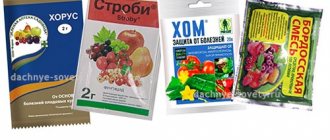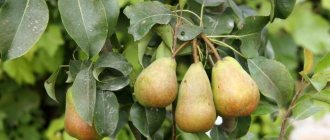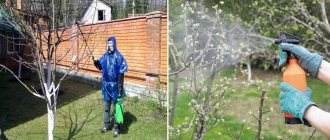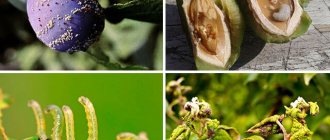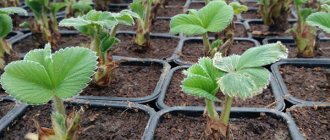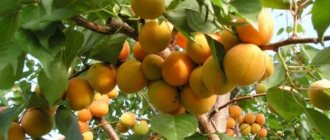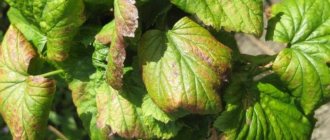Garden raspberries compare favorably with their forest ancestor in terms of yield, ripening time, size and taste of berries. However, the improvement of many traits in varietal raspberries is often accompanied by a decrease in resistance to diseases and pests.
What to do? Of course, don’t give up, but take up prevention and, if necessary, fight against harmful insects and diseases in order to save the berry harvest! And we will tell you the main ways to combat the most common raspberry diseases.
Of course, in all cases, preventing a disease is easier than treating it later. Therefore, when treating raspberries (as well as any other berry bushes) from pests and diseases, maximum attention should be paid to preventive measures - observing crop rotation, purchasing and planting obviously healthy seedlings, regularly removing weeds, timely watering and fertilizing, removing dry and withering shoots. Treatment of raspberries against possible or already identified diseases is also included in the list of necessary measures.
How to treat raspberries against late blight (root rot)
Root rot (phytophthora) of raspberries is a fungal disease that actively develops in heavy soils without drainage. Roots in waterlogged soil begin to rot and cannot fully nourish the plant. Accordingly, the ground part turns yellow, fades, and dries up.
Measures for the prevention and control of root rot (late blight) of raspberries:
- Plant seedlings that are known to be healthy (preferably with increased resistance to this disease), purchased from trusted manufacturers.
- Provide the plants in the area with a normal water regime (no stagnation of water at the roots), and drain the soil if necessary.
- If the plant is already sick, dig it up, inspect the root system for the presence of brick-red plaque, and if necessary, treat it with a fungicide according to the instructions (Polyversum WP, Prestop, Paurin).
How to treat raspberries against root canker
Root cancer is caused by bacteria that penetrate plant tissue through mechanical damage. As a result, galls with a brown smooth coating are formed on the roots. Later they grow together, crack and eventually move to the root collar. The roots stop fully absorbing moisture and taking nutrients from the soil. As a result, the above-ground part of the plant turns yellow and withers, the shoots grow short, the berries become smaller and lose their taste. As the disease progresses, the plant may die.
Measures to prevent and combat root cancer:
- Purchase and plant obviously healthy seedlings from trusted producers.
- Do not over-alkalinize the soil, observe crop rotation.
- Before planting, water the soil with a 1% solution of copper sulfate. In the same solution (100 g per 10 liters of water), soak the roots of the seedlings before planting (5-10 minutes, then rinse with water).
- For small lesions, dig up and burn diseased plants.
- In case of serious damage, destroy the diseased plants, change the location of the raspberry patch and do not plant cultivated plants in this area for at least 2-4 years.
Eliminating anthills
In the spring, immediately when the first leaves appear, aphids can cause great harm to raspberries. There are many varieties of these insects. Most of them can be easily gotten rid of even with a one-time treatment with folk remedies or chemicals, which were discussed above. But raspberries can be more persistently attacked by aphids, which are carried by ants. Ants reproduce and even protect this type of aphid from predatory insects (wasps, ladybugs, some types of flies) and then use the products of their vital activity as food. After treatments, ants can again repeatedly populate raspberries with aphids.
You should not leave anthills near raspberries, as ants spread aphids
Therefore, you need to make sure that there is not a single anthill near the raspberry tree. This is a very simple operation if it is not under the roots. You need to do the following:
- Dig out the soil with the anthill.
- Place it in water in an airtight container.
- After the insects have died, remove the anthill at a great distance from the garden.
If an anthill is located directly under the roots of a raspberry bush, the plant may soon die. Since it is impossible to dig up an anthill due to the proximity of the roots, it is enough to fill it:
- boiling water once or repeatedly with plain water, simply making a puddle in the place of the anthill;
- ammonium nitrate solution in a proportion of 500 g per 10 liters of water.
You can use recommended insecticides and other products that are incompatible with the ants' habitat. Sometimes it is enough to cover the trunk circle or anthill with a layer of ammonium nitrate, nitroammophosphate or diammophos. The main rule is not to poison the earth with too toxic drugs. The product should be destructive to ants and harmless or even beneficial to the soil.
How to treat raspberries against gray rot
Gray rot of raspberries is a common and quite dangerous fungal disease of plants. It also affects raspberries, beginning to appear at the moment of flowering, although usually the berries are more affected. First, the affected area (usually young, tender parts of the plant) is covered with gray “dust”, then it degenerates into a fluffy coating - these are sclerotia of the fungus. Subsequently, the disease enters a new stage - the plant rots and dies. The spores can be carried by the wind to other plants and infect them. Gray mold is most active in years when, against the background of low temperatures, there is excess moisture in the soil and air.
Measures to prevent and combat gray mold:
- Maintain crop rotation, do not thicken the plantings, water moderately and then loosen the soil.
- Promptly remove and destroy affected parts of the plant.
- Before fruit formation, it is permissible to treat the shrubs with fungicides according to the instructions (for example, Fitosporin-M - 5 g of powder is dissolved in 10 liters of water and the shrubs are sprayed 3-5 times per season with an interval of 7-10 days).
- Gray mold - signs of the disease and ways to combat it
How to understand that your plants are sick with gray rot and what can be done in this situation?
Chemicals
How to treat raspberries against pests in spring? Chemicals are often used, which can be purchased in specialized stores. The best of them are the following:
- "Nitrafen". Used to eliminate beetles by spraying. How to treat raspberries with this product? The drug (200 g) must be diluted in water (10 l). Another remedy helps prevent infection with anthracnose. Since the drug is dangerous for people and animals, it can only be used in an industrial environment, observing safety rules. Plants should be treated before buds break to avoid burns to the foliage.
- "Fufanon." The gall midge is eliminated with it. Processing raspberries is simple. The product (10 mg) must be diluted in water (10 l). It acts quickly, does not have an unpleasant odor, and is very easy to dissolve. The drug is affordable and not harmful to people.
- "Aktellik". How to treat raspberries with this drug? You will need 15 mg of Actellik and 10 liters of water. The composition is effective, easy to use, and has a reasonable price. But since it is toxic, they work with it in special clothing.
- "Chlorophos". How to process raspberries with it? You will need a 0.5-0.3% solution that protects against shoot gall midges. The procedures need to be performed 2 times a season. The first is carried out when the night temperature reaches 13 degrees, and the second – 10 days after that.
- Bordeaux liquid. This is the most suitable remedy for gray rot. At the beginning of spring, the concentration of the solution should be 3%, and before flowering - 1%.
Treating raspberries with these products gives excellent results. The main thing is to read the instructions from the manufacturer in order to carry out the procedures correctly.
How to treat raspberries against verticillium wilt (wilt)
Verticillium wilt is one of the most dangerous fungal diseases of raspberries, affecting the entire plant. The pathogen penetrates tissue through mechanical damage. As a result of its action, the tips of the shoots of the plants gradually begin to fade, the leaves dry out (first the lower ones, and then higher up the trunk), and bluish spots appear on the bark, merging into stripes. Subsequently, the bark cracks, and the shoots and roots completely dry out and die.
Measures for the prevention and control of verticillium wilt:
- Plant seedlings that are known to be healthy (preferably with increased resistance to this disease), purchased from trusted manufacturers.
- Do not place plants that can “share” this fungus (potatoes, tomatoes, peppers, eggplants, strawberries) next to berry bushes. Do not plant raspberries in the area after these plants.
- Destroy all diseased specimens, remove dry and withering bushes.
- At the initial stages of infection, treat raspberries according to the instructions with Previkur Energy, Maxim Dachnik, etc.
- If plants are seriously infested, they should be removed and the soil replaced completely to a depth of at least 30 cm.
How to treat raspberries against chlorosis
Raspberry chlorosis can be caused by various reasons, including depleted soils, increased acidity, poor drainage, etc. But we will talk about infectious vein chlorosis (Raspberry vein chlorosis), a viral disease. Its main feature is the yellowing of the leaves primarily along the veins, which then passes to the entire leaf blade. As a result, the leaves turn brown, the shoots become elongated and thin, and the berries dry out without ripening. The plant weakens and dies.
Active carriers of the chlorosis virus are aphids and mites. Infection can also occur during grafting of a diseased plant onto a healthy one, when the juice of diseased crops gets on a cut of a healthy one, or when using an undisinfected instrument.
Measures to prevent and combat infectious chlorosis:
- Plant seedlings that are known to be healthy (preferably with increased resistance to this disease), purchased from trusted manufacturers. These are raspberry varieties: Kolkhoznitsa, Cornish Victoria, Russian Harvest, etc.
- Disinfect garden tools with a 1% solution of potassium permanganate before starting pruning and other procedures.
- Control insect pests.
- Promptly remove and burn damaged raspberry leaves and shoots.
- Do not forget to feed healthy plants (humus, peat and compost once every 2-3 years at the rate of 5-6 kg per 1 sq.m.).
Time limits for different types of processing
In order for the measures to have a positive effect, it is recommended to comply with the processing time. Otherwise, the procedure will not give the expected result.
Treatments required for fruiting
Such treatments are carried out from late spring to early summer. The exact timing depends on the raspberry variety. There are early, middle, late ripening. Experienced gardeners recommend spraying plants before June 15. Most varieties begin to set fruit at this time. Correctly selected preparations stimulate the development of berries, affect their taste and presentation.
During fruiting
Ordinary and remontant varieties produce a harvest in the second year after planting. Fruiting is affected by the quality and composition of the soil, natural conditions, external factors and proximity to other plants. To strengthen the immunity of raspberries, treatments are used from late June to mid-July. Thanks to them, the berries grow large and sweet, and the yield increases.
After harvest
Fruiting of most varieties ends in August, after which summer residents begin processing. They use folk or chemical remedies - they protect the raspberries from diseases and pests, restore metabolic processes and prepare them for wintering.
In order for the drugs to be better absorbed, it is recommended to cut off old and dry shoots before the procedure. Excessive branches take away important nutrients from the shrub, causing the plant to weaken and wither.
How to treat raspberries against rust
Raspberry rust (Phragniidium rubiidaei) is another fungal disease that is especially common in areas with high humidity. Its main feature is small, round, slightly convex yellowish-orange pads on the upper side of the leaves, on their petioles and central veins, which appear in the warm season. Later, the pads burst and the spores fly away, spreading the disease throughout the garden. On annual shoots, gray ulcers with a reddish border form, which, as the disease develops, merge into lines and cracks - fungal spores preparing for wintering. The plant as a whole weakens and loses its winter hardiness, the leaves turn yellow and dry, and the yield drops sharply.
- Plant rust - signs of the disease and ways to combat it
If the leaves of the plant are covered with spots with a touch of yellow, red, red (less often brown) shades, then most likely the crop has been affected by rust.
Rust prevention and control measures:
- Avoid dense plantings, overgrowing the site with weeds, and cluttering it with last year’s plant debris.
- Mulch the berry bushes with manure (the microorganisms living in it destroy fungal spores), and regularly loosen the soil.
- Promptly remove and burn affected parts of the plant.
- Before bud break, the affected bushes can be treated with a 3% solution of Bordeaux mixture, 2% potassium salt or 4% ammonium sulfate solution (400 g of the drug per 10 liters of water).
- In case of severe damage, use fungicides several times a season according to the instructions (Prognoz, HOM, Topaz, Ordan, OxyHOM, etc.).
Effective means
The best folk remedies are:
- Treatment with boiling water. The procedure eliminates pests, viruses and fungi. This is carried out until the sap flows. You need to water the bushes with boiling water from a watering can. This way you can eliminate pests overwintering in the ground and eliminate colonies of viruses and fungal spores. For a better effect, add a weak solution of potassium permanganate or copper sulfate (1 tbsp) to the watering can.
- Use of urea. Treatment in this way is carried out against diseases and pests before the beginning of the growing season in order to eliminate overwintered infections and parasites. The product (400-500 g) should be diluted in water (10 l). The composition is used for spraying raspberries: 1 liter will be enough for 1 square. m. To saturate the plants with nitrogen and strengthen the immune system, 50 g of the substance must be diluted in the same amount of water and the shoots can be watered. This product eliminates aphids, weevils and raspberry beetle larvae. Since moisture is quickly absorbed, urea is stored in special containers.
- Ammonia. Microbes in the soil convert ammonia into nitrates, which are required for the development of green mass. To prepare the solution, dilute 30-40 ml of the finished substance per 10 liters of water. The plant should be watered 2 liters each. The procedures are performed at the beginning of spring.
- Boric acid. The product is used to improve productivity, so it is effective during flowering. 2 g of the substance is added to water (10 l).
- Mustard. This seasoning repels weevils. The powder (20 g) is diluted with water (10 l) and left for several hours. Baking soda has the same effect: 2 tbsp. l. for 10 l. water. During the flowering period, pest control should not be carried out.
How to treat raspberries from mosaic
Raspberry mosaic is a group of viral diseases that cause discolored spots and stripes on the leaves. With severe damage, convex areas appear on them, and the leaves become thinner and wither. If the weather is also unfavorable, you may completely lose the harvest, or even the raspberry tree itself. The virus is actively spread by aphids and mites, and pathogens enter the plant through wounds left by insect pests or tools, as well as through root shoots.
Prevention and control measures against mosaic:
- Purchase and plant obviously healthy seedlings from trusted producers.
- Do not place cultivated raspberries next to wild ones.
- Control insect pests.
- Remove and burn diseased shoots and plants in a timely manner.
- Remove weeds in a timely manner and feed raspberries throughout the season with superphosphate, potassium salt, manure or rotted compost.
How to treat raspberries against curl
Leaf curl of raspberry is a fungal disease that inexperienced gardeners can easily miss. The stems of the affected plant become stocky, thickened and dense; the leaves wrinkle, become smaller, and a bronze tint appears on the underside; the berries dry out and become sour. Without taking urgent measures, the raspberry tree can completely die within a few years. Infection can also occur during grafting of a diseased plant onto a healthy one, when the juice of diseased crops gets on a cut of a healthy one, or when using an undisinfected instrument. Aphids and mites are also carriers of the fungus.
Measures to prevent and combat curliness:
- Purchase and plant obviously healthy seedlings from trusted producers.
- Do not place cultivated raspberries next to wild ones.
- Disinfect garden tools with a 1% solution of potassium permanganate before starting pruning and other procedures.
- Fight insect pests (preparations according to the instructions: Aktara, Alatar, Inta Ts-M, Iskra, Konfidor Extra, Fufanon-Nova, etc.).
- Promptly remove and burn damaged parts of the plant.
How to treat raspberries against anthracnose
Raspberry anthracnose is a fungal disease that is most common in warm areas with high humidity. Externally, plant damage appears in the form of purple spots on the shoots. At first they are small, then they grow, become purple-gray and turn into leaves and berries, which dry out over time. The bark of the plant gradually turns gray, and the leaves die off.
Measures for the prevention and control of anthracnose:
- Purchase and plant obviously healthy seedlings from trusted producers.
- Avoid dense plantings, overgrowing the site with weeds, and cluttering it with last year’s plant debris.
- As a preventive measure, in spring and early summer, spray raspberry bushes with a 1% solution of Bordeaux mixture or a 0.5% solution of copper oxychloride.
- Promptly remove and burn affected parts of plants.
- In case of severe damage, treat with fungicides according to the instructions (Forecast, OxyHOM, Kuprolux).
When to treat raspberries to prevent diseases
Before protecting bushes from worms in berries and diseases, it is necessary to determine when it is best to carry out treatment. Experienced gardeners recommend treating the remontant bush in the spring, in the first half of April, when the first snow melts and the first buds begin to appear on the seedlings. In March, spraying is not carried out, since the daily temperature can drop below five degrees Celsius.
You can also treat plants in the fall, after the leaves have fallen. At the beginning of November, branches that have stopped bearing fruit are cut off from the bushes, and the most weakened shoots are removed. Only after preliminary pruning is preventive treatment carried out.
How to treat raspberries against septoria (white spot)
Septoria, or white spot, is a fungal disease. It appears in the form of spots on leaves and stems - round, first pale brown, and then whitish, edged with a purple outline. Affected shoots, buds and leaves die, raspberry bushes weaken and lose their ability to produce crops. The disease spreads especially intensively in humid weather.
Measures to prevent and control septoria:
- Plant seedlings that are known to be healthy (preferably with increased resistance to this disease), purchased from trusted manufacturers.
- Avoid thickening the plantings, overgrowing the site with weeds, and cluttering it with last year’s plant debris.
- Before the buds open, spray raspberries and blackberries with Bordeaux mixture or a 0.5% solution of copper oxychloride.
- Use fungicides according to instructions (for example, Prognosis).
- Promptly remove and burn damaged parts of the plant.
Spraying
If you don’t know what to spray raspberries with during flowering, it’s better to consult with experienced gardeners; this is the easiest and most reliable way not to lose face. If relations with neighbors are not established, and you don’t know any summer residents, then let’s figure out what’s what.
In the spring, you need to take care of treating raspberries from pests. During this period, it is best to use Bordeaux mixture and nitrophen.
It is necessary to treat raspberries with this composition before flowering and bud break because it is better not to disturb young flowers, which may not produce a harvest due to stress.
In the summer, raspberries are treated against pests before flowering if spring procedures do not produce results. If signs of disease begin to appear on the bush and leaves, spots or leaves begin to turn yellow, you must first determine the disease.
If, for example, your bush suffers from powdery mildew, it is better to use the store-bought product “Topaz”. If you need to treat raspberries before flowering against pests, and you are against the use of chemicals, you can use folk remedies, for example, a decoction of pine needles can destroy gray rot.
How to treat raspberries against didimellosis (didimella)
Purple spotting, or didymellosis, is a fungal disease that affects all parts of the plant. First of all, the disease manifests itself on young (one-year-old) shoots, petioles and buds. Small brown or violet-brown spots appear on them. Over time, they grow, darken and ring the shoot. The bark cracks and peels, and soon dark brown spots form on the leaves. The pathogen spores spread to other plants by wind, water, insects, through soil and planting material.
Measures for the prevention and control of didymellosis:
- Purchase and plant obviously healthy seedlings from trusted producers. Increased resistance to this disease was noted in raspberry varieties: NovostKuzmina, Alye Parusa, Skromnitsa, Bryanskaya, Sentyabrskaya, Chief, Julia, Brigantina, etc.
- Avoid thickening the plantings, overgrowing the site with weeds, and cluttering it with last year’s plant debris.
- For prevention, treat raspberries before buds open with a 7% urea solution (700 g of fertilizer per 10 liters of water);
- Provide the plants in the area with a normal water regime (no stagnation of water at the roots), and drain the soil if necessary.
- Control insect pests (especially shoot gall midges - see below).
- Promptly remove and burn affected parts of plants.
- In case of severe infection, use fungicides according to the instructions (Fitolavin, Topaz).
What feeding does remontant raspberry need in July?
Varieties of remontant raspberries bear fruit several times a year, so gardeners pay special attention to caring for shrubs. In July, most varieties begin to bear fruit - raspberries need mineral fertilizers (potassium, nitrogen, phosphorus)
They are applied by root and foliar methods. Mineral fertilizers stimulate fruiting, improve the quality of fruits, and serve as a preventative against diseases and pests.
Symptoms of deficiency
You can determine which microelements raspberries lack by their appearance. When there is a deficiency of substances, spots and dots appear on the bushes, shoots dry out, leaves curl and fall off:
- light green wilted leaves indicate a lack of nitrogen;
- curly and darkened - raspberries lack potassium;
- thin and brittle shoots - phosphorus deficiency;
- yellowness of leaves and small brown dots - lack of boron;
- a change in the color of the veins on the leaves indicates iron deficiency;
- deformation of berries and discoloration of leaves - lack of manganese.
A deficiency of microelements is dangerous because raspberries' immunity is weakened, and the plant is more susceptible to diseases and insect pests. Many gardeners think that raspberries are an unpretentious plant that does not need feeding. This is a misconception, especially when it comes to remontant varieties.
Raspberry pest control measures
Raspberries are a fairly unpretentious plant, so caring for them does not cause gardeners much trouble. But, unfortunately, when it is grown in open ground and in the vicinity of other garden crops, there is no escape from all sorts of harmful insects that could potentially reduce the expected yield or even threaten the death of the plants. Let's learn together how to timely treat raspberries from dangerous pests.
- Raspberry and blackberry pests - effective control methods and prevention
Find out which insects cause damage to your plants and how to treat raspberries and blackberries against pests.
Of course, in this case, as in the case of diseases, prevention should be at the forefront. It is important to follow the regime of watering and fertilizing raspberries, regularly thin out the thickets, remove dead shoots, and clear the area of plant debris.
- 7 pairs of plants that should not be grown side by side
14 plants that absolutely cannot “tolerate” each other.
What insects harm raspberries?
Alas, not only you and I love to eat raspberries, but also numerous garden pests, which you need to know by sight in order to deal with the scourge in a timely manner.
- Who eats raspberries - 5 most dangerous pests
What raspberry pests are considered the most dangerous, and why are they so difficult to detect? Find out from the article right now.
Raspberry beetle
Since early spring, an adult insect feeds on flowers and damages shoots, while its larvae are capable of destroying almost all young tender parts of the plant. Without taking emergency measures against this insect, you can lose all the ovaries and the harvest in principle.
Raspberry stem gall midge
This microscopic raspberry pest is very dangerous, despite its size. Adult insects lay eggs inside the stem, and the larvae that emerge from them then begin to actively gnaw passages inside the plant, literally destroying young shoots. Their presence can be noticed by the presence of swellings-galls under the bark.
Raspberry stem fly
This small gray insect lays larvae in the axils of leaves or at the top of stems. The larvae begin to bore into the insides of the young shoots, which turn black and dry out completely over time. Thus, stem flies can destroy up to 80% of the entire raspberry tree!
Raspberry mite
This insect overwinters directly in the buds and emerges from their shelter in early spring, beginning to feed on the juices of the plant. They like to settle on the underside of young leaves, leading to their deformation and thinning.
Spider mite
If the rules for watering plants are not followed (especially in dry weather), they are often affected by spider mites. The pest feeds on the sap of the leaves, as a result of which they become deformed and soon dry out. You can notice it by the presence of a thin web on the underside of the leaves.
Raspberry-strawberry weevil (flower beetle)
First of all, it damages flower buds, where it lays eggs, and the hatched larvae begin to feed on the tissues of the ovary. If the stalk is not gnawed and the flower does not fall off, the pest may subsequently spread to the leaves of the plant.
Why is it required?
Treating raspberries against pests in the spring is an important procedure. Thanks to her, you will be able to get rid of beaten and frostbitten shoots. And also eliminate diseases and pests.
If you do not periodically carry out the procedure and do not perform maintenance, then the latter will very soon be all over the bush, and then the entire seedling will need to be removed from the ground. In addition, shoots damaged by the disease sometimes dry out and die off on their own. But sometimes the plant develops, trying to survive, produces flowers and bears fruit.
Pests multiply quickly and occupy the entire plant. They eat greens, leaf juice, and internal plant juices. If insects are on the leaf, they can be neutralized by treating with insecticides. Pests that have settled on the roots and bark will be destroyed only when part of the shoot is removed.
The structure of the berries is deformed by pests and they will not be able to fully develop. Raspberries will not have the deep pink tone that they usually have. The bright taste is also lost. Therefore, the sooner you identify diseases and pests, the faster you can get rid of them. Otherwise, they can spoil all the raspberries.
